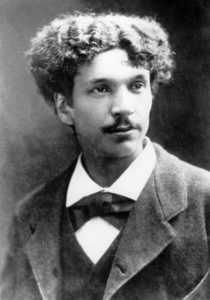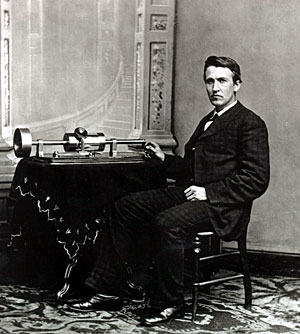Eager grade school students will keep waving their hands in the air even after a question has been answered. So, when you call on one of the remaining hands, the student often says:
“She took mine!”
There may have only been one possible answer—as obvious as a camel on stilts—but we still want credit for knowing. The world should know we had the right idea, too. And, we probably had it first and the teacher just called on the wrong person even though you waved your hand like a high-speed windshield wiper and shouted “oo, oo, I know, I know.” It was bad luck or, on bad days, a conspiracy to thwart your imagination. So you point out that “she took mine” with the obvious implication that she should be prosecuted in Idea Court under the standard of fair recognition of my own ideas.
History is littered with two people (and sometimes more) having the same idea simultaneously. But, for some reason, we still want to know who was first and bestow the requisite glory, even though the alleged runner-up’s work is equally valid.
Darwin was urged to rush the publication of On the Origin of Species when Darwin received Alfred Russel Wallace’s essay on evolution. Their papers were presented jointly.
German mathematician, David Hilbert, first helped Einstein with equations for a general theory of relativity and then raced to complete the formulas on his own. Einstein beat Hilbert by two days.
Charles Cros submitted to the French Academy of Sciences a sealed envelope with his designs for the phonograph on April 10, 1877. American Thomas Edison began work on his phonograph in June 1877 and was granted a U. S. patent on January 15, 1878.
The two phonographs were nearly identical. Edison used tinfoil on a cylinder to record sound. Cros used lampblack. Edison called his a phonograph—Greek for sound writing. Cros called his a paleophone—Greek for sound from the past. (Curiously, though, Cros had used “phonograph” in a short story that he wrote in 1872.)
Edison and Cros never met. Prior to the acclaim for the Edison phonograph, neither had even heard of the other. If you draw the trajectories of their lives, it looks like an ‘X’ with 1877 at the very center of the two crossing lines.
They both had the same idea at roughly the same time. Their minds were in sync, both following an identical path in their thinking about the mechanical reproduction of sound.
 Charles Cros
Charles Cros
Cros was the son of a professor who lost his job when he refused to swear allegiance to Napoléon the III. Edison was the son of a lumber and feed dealer in Milan, Ohio. When the railroad bypassed Milan, the Edisons moved to Port Huron, Michigan. Both, Edison and Cros grew up poor and were non-conformists who taught themselves. Edison lost most of his hearing at age 12; at age 19, Cros began teaching at the Institut Sourds-Muets (Institute for the Deaf and Mute) in 1861, where he began to think about a machine that would help the deaf hear.
Both men faced poverty. Edison responded with ambition and became a lifelong entrepreneur beginning by selling newspapers on the train between Port Huron and Detroit. Cros sought to escape through poetry, writing poems like La Vie Idéale, (The Ideal Life) and Croquis d’hospitalité (Sketch of Hospitality).
Cros published his first volume of poetry in 1873. Four years earlier, Edison had quit being a telegraph operator to become a full-time inventor.
Edison built his first phonograph prototype in 1877 and soon after launched a public relations campaign. The Edison Talking Machine greeted the editors of the Scientific American with a recording inquiring about the editors’ health, informing them that it—the machine—was well, asking how they liked the phonograph, and bidding the editors good night. Edison sent his associates all over the nation to give entertaining demonstrations advertising that “Every man, woman, and child should see this great curiosity.” He was heralded as a “wonder of the age,” he became the celebrity inventor.
Cros, on the other hand, presented his paleograph design to the Academy of Sciences on April 30, 1877—before Edison had even started. The Academy smirked with indifference. He could not raise a single sou to build a prototype. He later let the rights to his invention slip away. Edison claimed the French patent for the phonograph in December 1877.
Cros continued to write poetry, short stories, songs and short humor pieces. He socialized in the circles of Bohemian artists who met at the Chat Noir in Paris, including among others Paul Verlaine, Claude Debussy, Erik Satie and Henri de Toulouse-Lautrec. (For a time Cros lived above the café.)
Cros continued to experiment and tinker. He made the essential contribution that would later lead to color photography. He believed that he could see cities on Venus and Mars and proposed a system of arc lights and mirrors positioned on the North Pole to flash signals to our planetary neighbors. He wrote a love story about an earthling who fell in love with a Venetian woman. The would-be lovers communicate through his imagined arc lights.
But, Cros also gave considerable thought to how the technology of the phonograph and telephone would impact society. Long before Charlie Chaplin’s Modern Times, Walter Benjamin, George Orwell and Edward Snowden, Cros recognized the danger of the mechanical collection of individual data. The ability to talk and record—sound and sight—meant that you could be unknowingly heard and recorded. He anticipated a time when a powerful centralized government or commercial power could know everything about everyone.
In 1880, Cros wrote a short story called Le Journal de l’avenir (The Journal of the Future) describing the use of telephones to control the society of 1986. The brains of talented people are seized by the government. Writers and poets listen to the phones so that they know everything that happens and all the gathered information is routed back to a central control.
A powerful commercial entity collecting data on everyone and everything? Maybe not in 1986, but certainly today thanks to Google, Amazon, Facebook and others. And who knows how much information the government collects on us?
Even in the 19th century, Cros knew that the government was adopting the new technologies to tighten its control of the people. Microphones—invented in 1827—were planted in the walls of prison cells to secretly eavesdrop on prisoners. Police were using photography to identify and track criminals. Cros was an active communard in the 1870-71 rebellion. He saw how the Army used photography to track down suspected communards.
Charles Cros blended scientific and artistic imagination—each fed the other. He was equally at home at the Academy of Sciences and the Chat Noir artist café. Sadly, he devoted too much time to drinking, particularly absinthe. He died in 1888, 45-years old.
His friend Alphonse Allais, a fellow poet and humorist, eulogized Cros in print:
What did he lack to become a successful man, honored and decorated? Almost nothing… He wrote superb verses that earned him nothing, wrote as a lark those monologues that made Coquelin Cader famous, had brilliant scientific ideas, invented the phonograph, color photography, the photophone (in his Cerebral Mechanics, Charles Cros described a theoretical device that caused hearty laughter in the Academy Of Sciences: light that speaks! Two years later, an Englishman invented the same apparatus, which he called the photophone and was awarded a prize of l00,000 Francs by the same Academy).
Cros never patented his ideas, only to see others claim credit and profits that might have been his. If ever anyone had the right to say “he took my idea” it is Cros.
Charles Cros is buried in a family plot in the Montparnesse Cemetery in Paris. A memorial tombstone should be added inscribed:
Il ont pris les miens.
(He took mine.)





